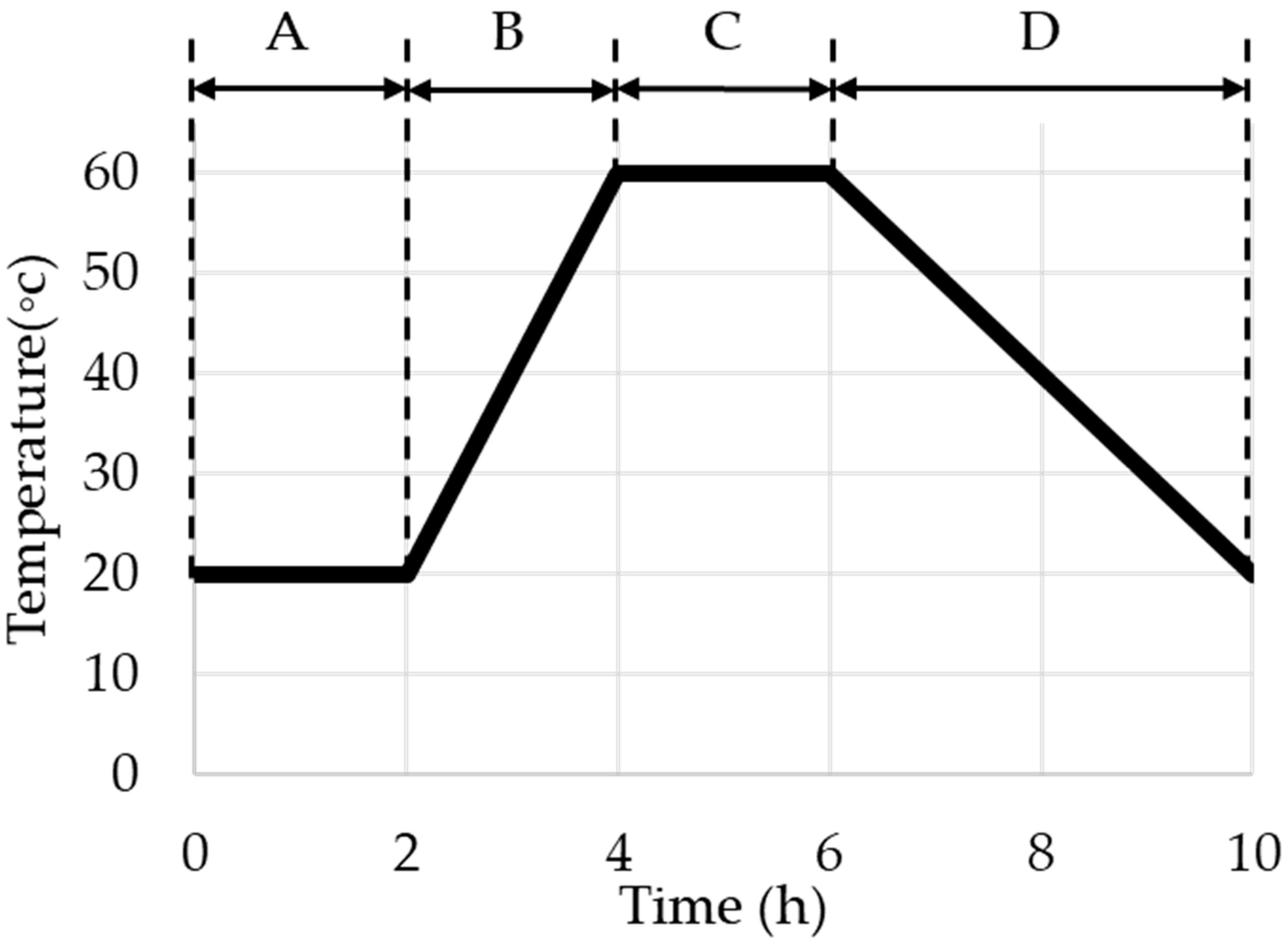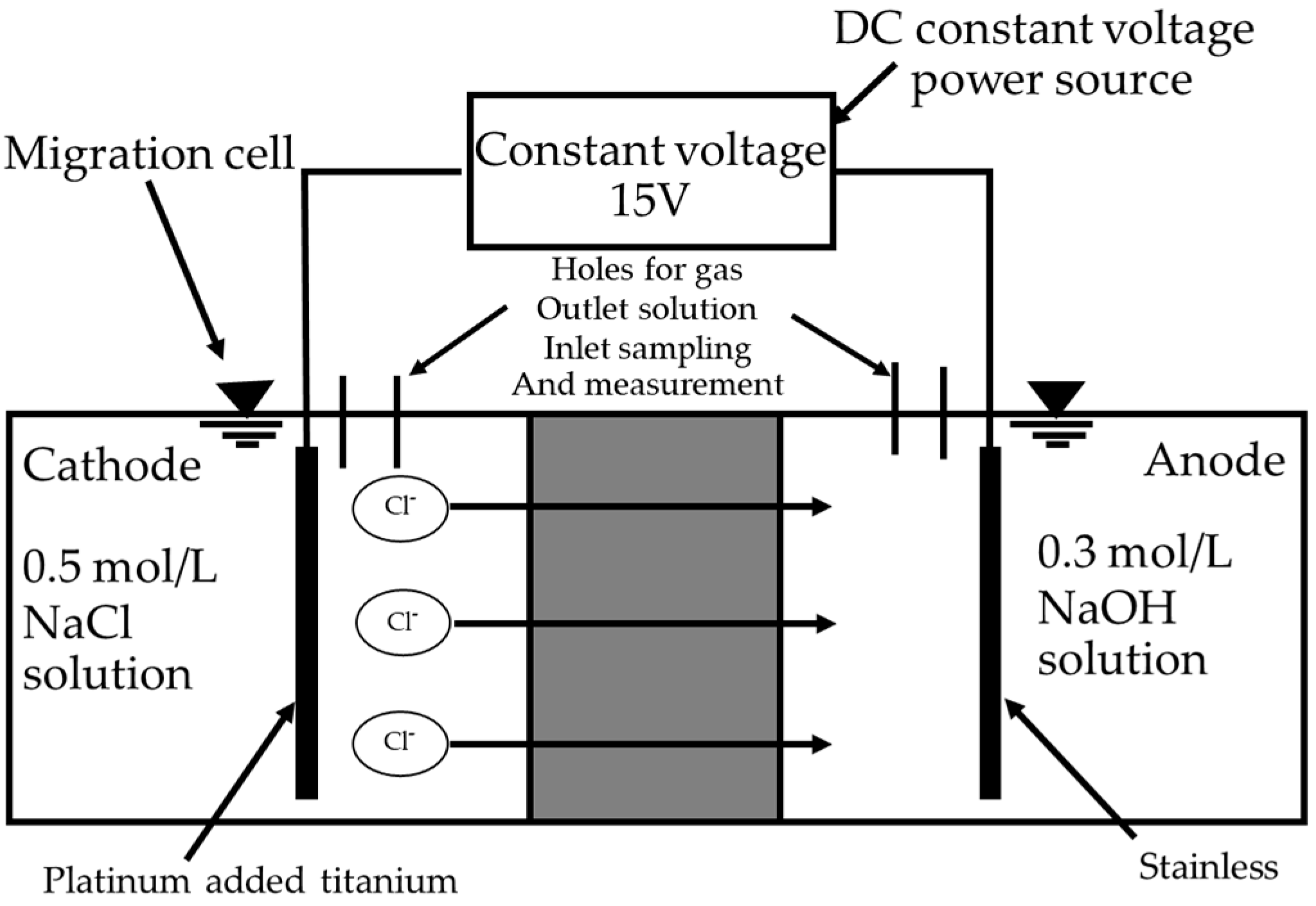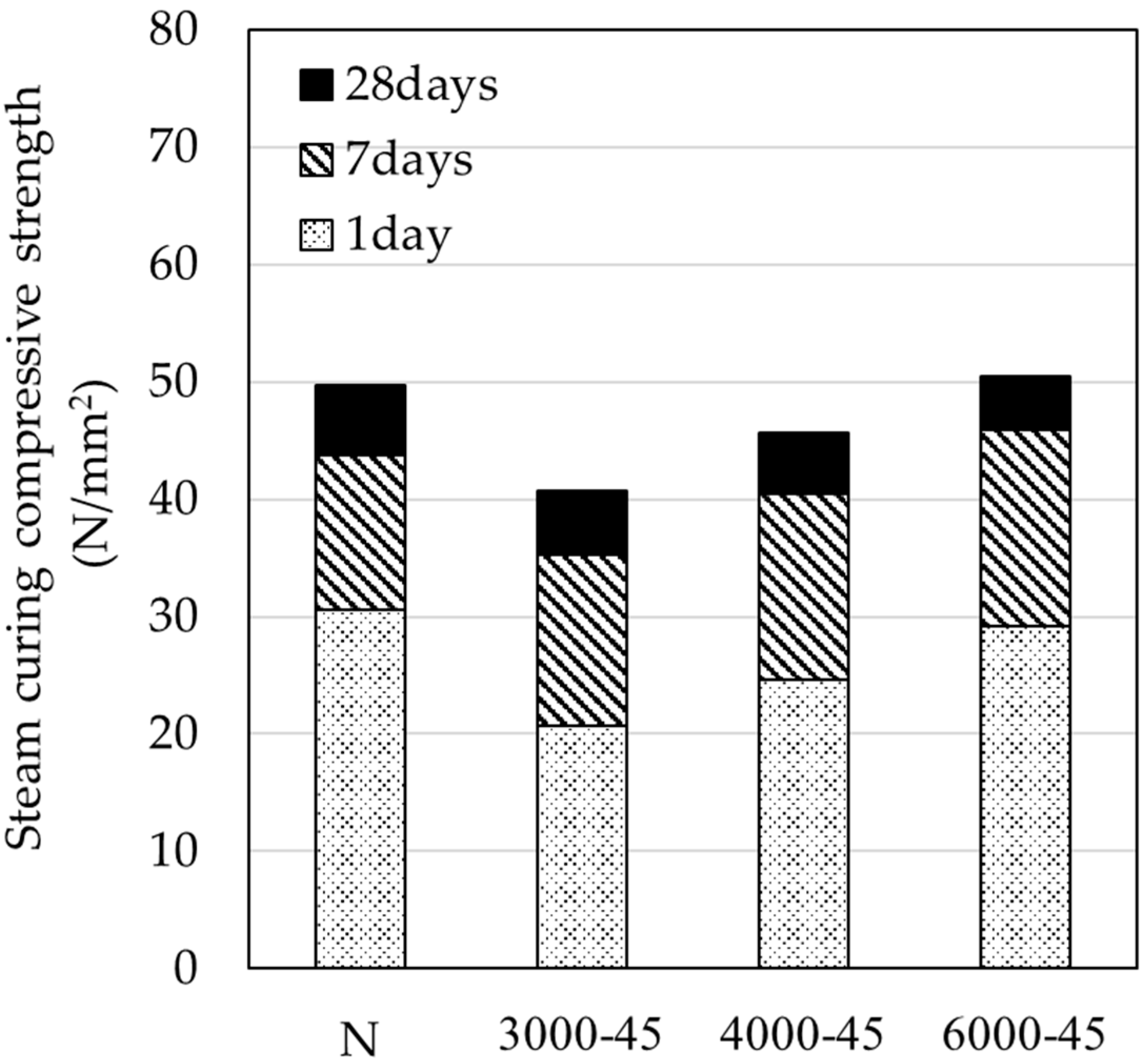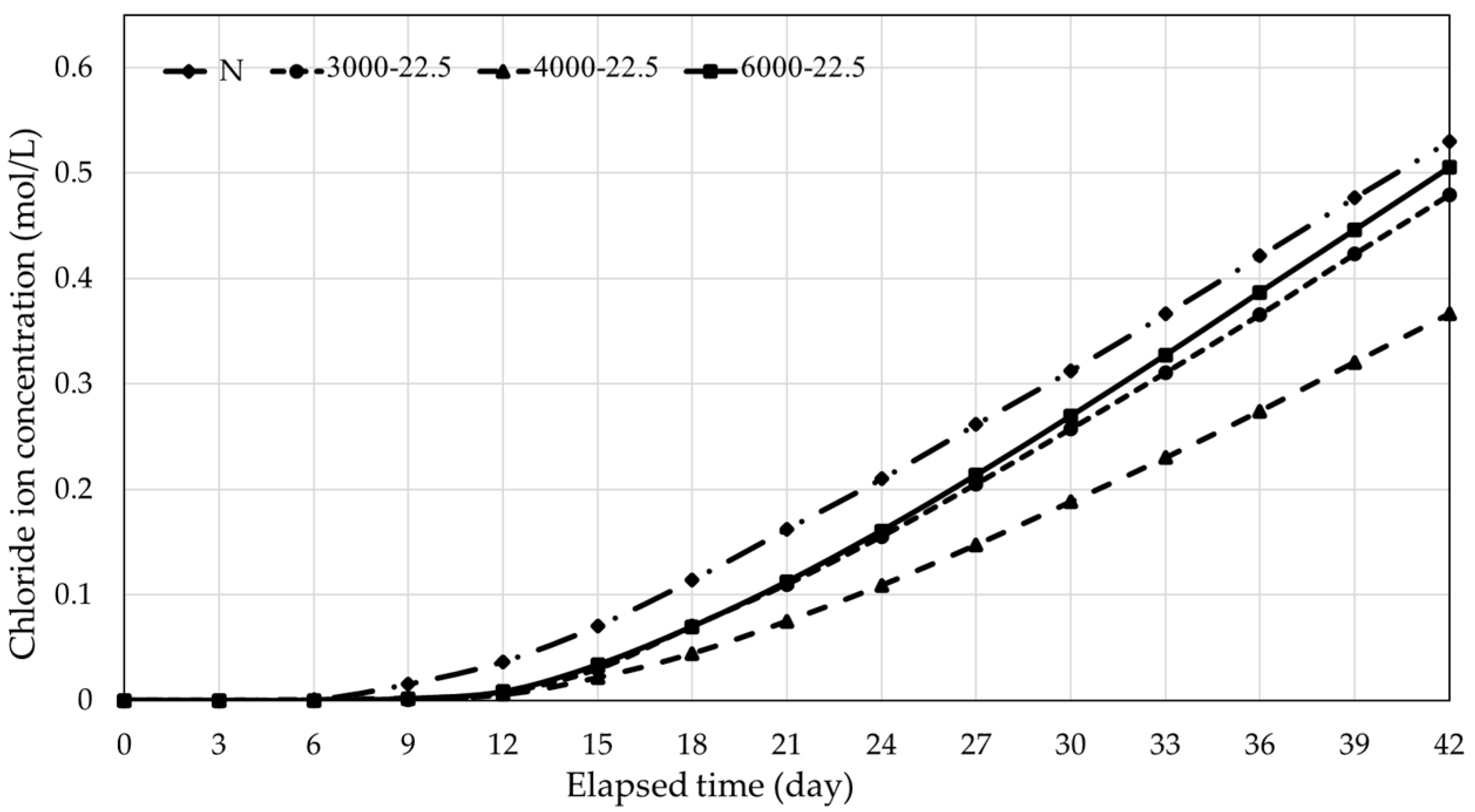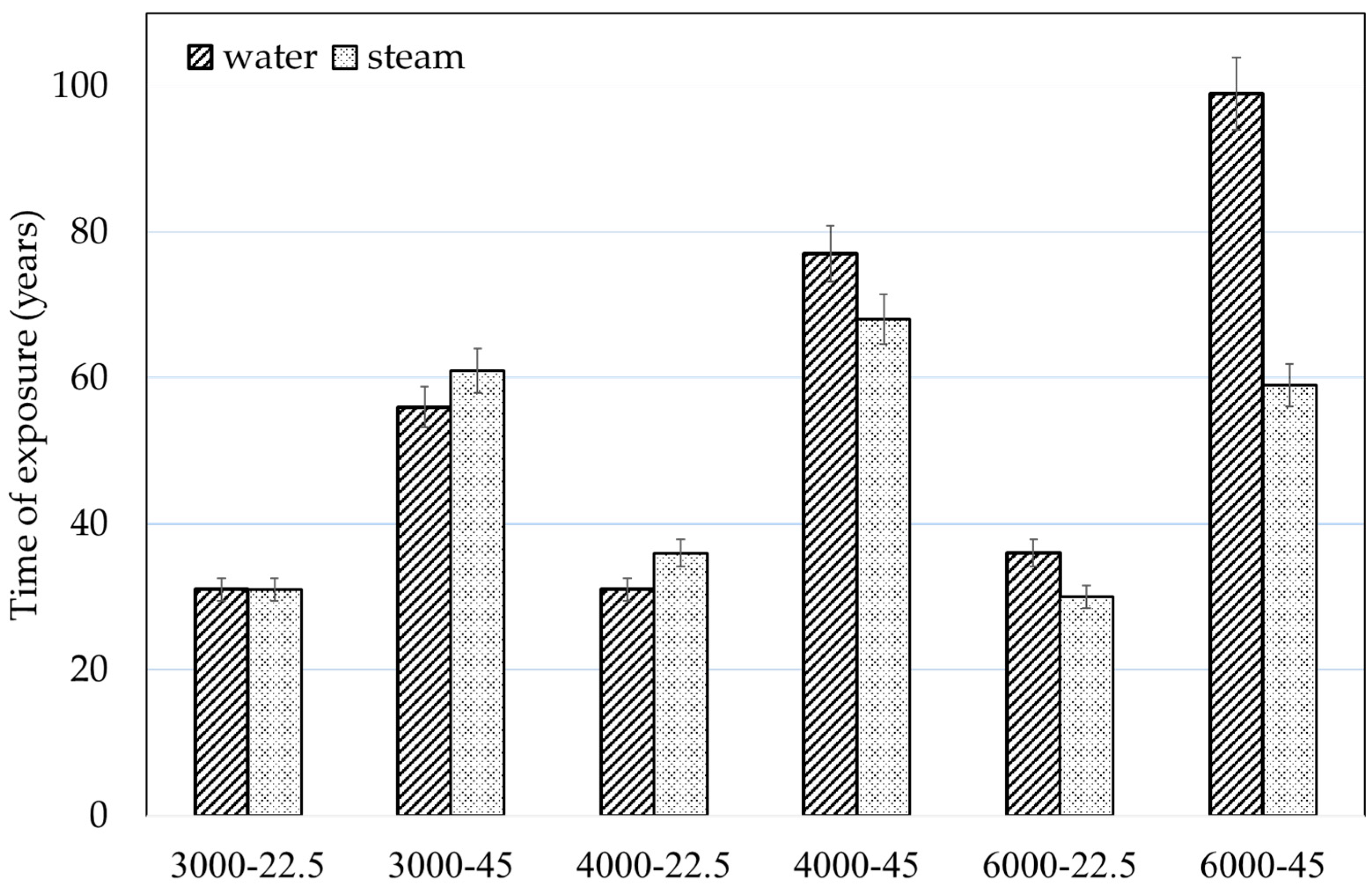1. Introduction
Concrete is more widely used than any other manufactured material and has been a construction staple for centuries [
1]. However, several theories on the deterioration of reinforced concrete (RC) show that direct current (DC) tends to corrode steel reinforcement, and chlorides are chemically bound by the cement paste (tricalcium aluminate, C
3A) [
2].
In marine environments, a significant reason for the collapse of RC structures is the corrosion of steel reinforcements, which creates a course for the penetration of chloride through the concrete surface, which comes into contact with internal reinforcement, leading to rebar oxidation and corrosion. Therefore, chloride-induced reinforcement corrosion is considered to be the main cause of concrete deterioration. In addition, rust occupies volume and creates tensile stresses in the concrete, resulting in spalling and cracking [
3].
Chloride-induced corrosion is the most significant problem affecting aging concrete structures, especially in maritime environments or areas where salts are utilized. Chlorides can be incorporated into concrete or diffused from the outside environment, such as from saltwater or deicing salt. When Cl
− reaches the reinforcing steel, it combines with hydroxide to produce a passive oxide layer, which penetrates and causes a crack. Cl
− can cause a breakdown in the passive steel oxide layer, allowing corrosion to proceed. Steel corrosion in concrete can be reinforced by oxygen starvation, especially when oxygen is only at the cathodic areas of steel in solution at the anode [
4]. According to [
5], carbonation and chloride diffusion processes require several years to reach the reinforcing steel in concrete during the period of corrosion initiation. Equations for Fick’s law of diffusion may be used to numerically predict the time required for chloride diffusion or carbonation to pass through the concrete covering and initiate corrosion in the RC structure. Covering thickness, quality of concrete, and the environment are possible factors that affect the structure’s initial properties and age. Chloride levels at various depths in concrete and carbonate depth are another possible reason. The passive layer is damaged from the point of corrosion initiation to the first signs of corrosion damage. Therefore, the corrosion period can be estimated using modeled equations that calculate the corrosion time and rate, which determine the deterioration of RC in a given environment. For example, corrosion of a concrete infrastructure due to seawater reduces the ultimate service life of an RC structure.
The durability of concrete constructions is intimately connected to the durability of the component concrete material. Therefore, the environmental effect is increased with Portland cement, which causes the expansion and deterioration of concrete. The leading chemical causes of concrete deterioration are alkali–silica reactions, alkali–carbonate reactions, carbonation, sulfate attacks, chloride attacks, and steel corrosion. A combination of various factors also frequently causes the deterioration of concrete structures. In addition to those given above, acting alone or in combination, other factors such as high structural stresses, thermal stresses, shrinkage, poor quality of materials, and inadequate maintenance may exacerbate the situation [
3]. One of the major factors contributing to the corrosion of marine RC structures is the chloride-induced corrosion of steel reinforcements, which substantially impacts structural service life [
6]. This has been intensively researched for decades, prompted by the rising maintenance costs resulting from the impacts of seawater exposure on coastal structures [
7]. Although concrete is an ideal material to protect steel reinforcement due to increased alkalinity, RC marine structures are highly vulnerable to corrosion due to chloride attacks. The severity of the attack is dependent on climatic conditions, among other factors [
8].
When partially penetrating the concrete, chloride is captured to react with C
3A to obtain calcium chloroaluminate (3CaO·Al
2O
3·CaCl
2·10H
2O), called Friedel’s salt, and also reacts with C
4AF to form calcium chloroferrite (3CaO·Fe
2O
3· CaCl
2·10H
2O). The unbound fraction of chloride is referred to as free chloride. It is an aqueous solution in concrete voids (pore solution). This free chloride is part of the chlorine. Polysaccharides that can diffuse into concentrated concrete of free chloride are lower in number. Moreover, the pore solution reduces alkalinity in concrete to catch large amounts of chloride. The advantage of using high C
3A cement is good chloride corrosion resistance. On the other hand, sulfate corrosion resistance requires cement with low C
3A, which is a contradiction [
9].
The aforementioned study revealed that chloride ion permeability in RC structures induces corrosion, disrupting and reducing the structure’s performance, and concrete shrinks and cracks as a result. The diffusion coefficient of the chloride ion in offshore construction was used to evaluate the durability of concrete and mortar. By first decreasing chloride ion penetration, reinforcement corrosion could be delayed [
10,
11].
The moisture content of concrete significantly impacts its long-term durability [
12]. Water absorption is generally caused by structural porosity (interlayer C–S–H), porous paste, and the aggregate interface zone, particularly in the early stages. Additionally, the physical adsorption of chloride caused by the C–S–H gel can assist in chloride immobilization. The mechanism of concrete deterioration caused by chloride ion infiltration and carbonation follows: (1) Friedel’s salt is formed when monosulfate (AFm) reacts with chloride ions; (2) Friedel’s salt is carbonated; (3) chloride ions immobilized in Friedel’s salt dissolve into the pore solution; (4) chloride ion concentration increases in the pore solution, increasing chloride ion penetration into the concrete through concentrating and diffusion cycles. Owing HCl acidity, the alkalinity of the concrete slightly decreases from 12.5–13.5 to grades 11, 10, and 9. The area where the film was destroyed has a negative electric potential in an electrolysis reaction. “Anodic reaction” is the term referring to this type of reaction [
9]. BFS is produced by grinding granulated blast furnace slag (GGBFS), a byproduct of pig iron manufacturing, and features high latent hydraulic properties. BFS is used as an admixture in Portland BFS cement at 40% to 45%. The advantage of Portland BFS cement is that its long-term strength is more enhanced, and it has higher resistance to seawater and chemicals. In addition, the diffusion coefficient of chloride ions makes the cement suitable for offshore structures. Furthermore, alkali aggregate reactivity is suppressed, the cement can be used with recycled aggregates, and a lower heat-release rate effectively suppresses thermal cracking [
13].
Chloride damage resistance is required when BFS is used. The hardened concrete is denser than ordinary Portland cement [
13], as it has a solid capability for incorporating chloride ions [
14]. Limestone (CaO) and silica are the main components of iron and steel slag (SiO
2). Alumina (Al
2O
3), magnesium oxide (MgO), and a minor quantity of sulfur (S) are several other components of BFS, whereas steelmaking slag contains iron oxide (FeO) and magnesium oxide (MgO). In the case of steelmaking slag, the slag contains metal components in oxides such as iron.
Because of the limited refining time and the significant amount of limestone, several auxiliary limestone materials may remain undissolved as free lime [
15]. Portland cement is divided into four main compounds: tricalcium silicate (3CaO·SiO
2), dicalcium silicate (2CaO·SiO
2), tricalcium aluminate (3CaO·Al
2O
3), and tetra-calcium alumino-ferrite (4CaO·Al
2O
3·Fe
2O
3), which are comparable to some of the BFS components.
Focusing on the mechanisms of chloride penetration in concrete and reinforcing steel corrosion, a previous study [
13] developed corrosion protection, repair strategies, and detection techniques to provide reliable and practical design approaches for durability and corrosion protection for concrete reinforcing steel. To develop mechanistic and practical models (deterministic or probabilistic), the study [
13] can be used to design durable concrete structures. Furthermore, it can be used to predict the deterioration and maintenance optimization of existing concrete structures to achieve a specified design life [
13].
BFS can improve the resistance of cementitious materials to sulfuric acid attack as the influence of concrete quality on diffusion coefficients is related to the concrete pore structure. Time dependence is due to the hydration of cement particles and chemical reactions of seawater ions with hydration products, which reduce the pore structure. When BFS is used, sulfuric acid has a small effect in terms of erosion; instead, the high-strength concrete or mortar becomes more durable, owing to the enhanced capacity to withstand sulfuric acid. Furthermore, BFS can suppress the penetration of chloride ions, inhibit steel corrosion, and reduce time-dependent strains [
9,
10].
BFS was used as the aggregate to investigate corrosion initiation on RC structures in one study [
16]. That study focused on the physical and chemical attacks on RC structures during their service life and investigated whether any protections might be placed to mitigate the degeneration caused by these attacks. It was found that the concrete performance may be improved by including mineral additives in cement, such as silica fume, blast furnace slag (BFS), and fly ash [
16].
A literature review reveals many studies of BFS-containing concrete in various countries. However, few studies have examined its use in reducing chloride ion permeability as the main factor of corrosion reactions. Thus, this study utilizes BFS as cement to investigate the performance of concrete in terms of delaying chloride ion penetration, which affects corrosion reactions. Furthermore, an experiment was conducted to examine improvements in the performance of an alternative concrete using BFS as cement replacement, focusing on chloride diffusion on concrete with BFS. This study aims to develop products for use in the precast concrete industry toward extending the life of concrete structures, especially reinforced concrete structures in marine environments.
4. Results and Discussion
4.1. Compressive Strength
This study shows that the Blaine value rate has a significant effect on compressive strength. However, in addition to enhancing the BFS addition rate, a more significant change was discovered, confirming the influence of the Blaine value. The pore structure became denser, and the hydration reaction was sufficient because the surface area increased as the Blaine value increased.
According to this study, the BFS cement replacement ratio was 22.5% and 45%. The existence of steam curing increased the compression strength of BFS 6000 Blaine as 45% BFS cement replacement increased, whereas water curing decreased the compression strength of both 3000 and 4000 Blaine.
Figure 3 and
Figure 4 show the compressive strength result of steam curing and water curing, respectively. Compressive strength increased as BFS Blaine fineness increased in curing conditions; for example, the 6000 Blaine showed significant intensity increases.
Figure 5 presents a comparison of the compressive strengths. In addition, it was found in this study that steam curing increased the compressive strength after seven days, considering that the hydration reaction was promoted by steam curing rather than water curing.
According to the results, the addition of BFS influences the development of compressive strength. BFS had a low hydration speed at an early age, so the development of compressive strength over 28 days was slow. On the other hand, compressive strength was a significant development in BFS cement, more than ordinary Portland cement in the long term. When comparing the curing conditions, steam curing resulted in lower compressive strength than water curing because the addition of BFS, as influenced by the curing temperature, resulted in changes in hydration speed that influence early strength development.
4.2. Effective Diffusion Coefficient (De)
The effective diffusion coefficient and concentration were established to verify the salt-preventive properties, whereby chloride ions on the cathode side penetrate the specimen in the electrophoresis test and permeate to the anode side. This study shows the effective diffusion coefficient results in both curing conditions, indicated in
Figure 6 and
Figure 7. The concentration rate was increased by water-curing conditions and featured high salt damage resistance by suppressing the penetration of chloride ions. The effective diffusion coefficient and the salt-preventive property were increased by the BFS Blaine value and water-curing condition. On the other hand, the result of the effective diffusion coefficient by RCPT was not affected by the steam-curing condition and Blaine value.
Comparing the BFS replacement rate ratio confirmed that 45% BFS cement replacement of both steam curing and water curing increased the rate of salt-preventive properties. The BFS replacement rate ratio of no addition and 22.5% were of no significance to the salt-preventive property, which might have been caused by the effect of voids and pore structure.
Figure 8 and
Figure 9 show the concentrations for water curing, and this is shown for steam curing in
Figure 10 and
Figure 11. Therefore, the increase in BFS replacement rate ratio might have been affected by the chloride concentration and the salt-preventive property in both curing conditions. In water curing, the higher the Blaine value, the lower the ion concentration, whereas no correlation was observed in steam curing. Therefore, when comparing the curing methods, water curing tended to increase salt-preventive properties. However, this study also considered the Blaine value, which may increase the volume of voids due to steam.
4.3. Chloride Immobilization
When BFS replaced cement, the performance of concrete in terms of its properties was improved. This was possibly due to conventional macroeconomic diffusion theory, which is based on Fick’s law. On a microscopic level, a second possibility is based on electrochemistry theory. The diffusion model, which is based on Fick’s second law, was used in this investigation. This diffusion model could be used to predict how long it takes for chloride to reach and initiate corrosion at the depth of the reinforcing steel. Furthermore, diffusion coefficient values could result from a study to determine the prediction time from the concept of Fick’s second law.
For one-dimensional diffusion into a semi-infinite medium, the following error function solution is often used [
25]:
where
D: diffusion coefficient (m2/s);
t: time of exposure (s);
C(x,t): chloride concentration at depth x after time t (% wt of concrete);
Cs: surface chloride content (% wt of concrete);
C0: initial chloride content (% wt of concrete);
erf: error function.
Uncertainty analysis started with a study of the diffusion coefficient in the series analytical solution that affected the variability of effective diffusivity, adjusted for each dataset. Corrosion prediction time was calculated on the basis of Fick’s second law as in the equation noted above.
Figure 12 presents these results for both curing conditions and various Blaine values obtained for each value of effective diffusivity. Water curing influenced the chloride diffusion properties, as the study shows that replacement of 45% cement with 6000 Blaine of BFS delayed chloride diffusion. Thus, extending the time to product corrosion reaction with the 22.5% replacement rate significantly decreased chloride diffusion.
4.4. Effect of Physical Characteristics on Amount of Friedel’s Salt Produced as Determined by X-ray Powder Diffraction (XRD)
This study compares the result of X-ray diffraction data of cement paste partially replaced with BFS at an age of 28 days. The results were compared before and after 28 days of the specimen’s immersion in saltwater, indicating that Friedel’s salt was formed. The experiment with different Blaine values and intensity counting for chemical product materials in
Figure 13 shows non-replacement, and replacement with BFS with 3000, 4000, and 6000 Blaine values, where the X-axis is the angle of reflection and the Y-axis is count intensity. The area of the diffraction peak was obtained by functionally fitting the diffraction peak by the method of least squares and calculating the intensity.
Chloride intensity determined from the XRD experiment is shown in
Table 4, compared with aluminum oxide as standard material. When calculating Friedel’s salt, which is an indicator of delay penetration, there was an increase in Friedel’s salt over time, as shown in
Table 4, obtained by the Friedel’s salt correction calculation. When Friedel’s salt substance intensity (counts) and aluminum oxide (
) substance intensity (counts) obtained from the XRD experiment were added to Equation (4), the results show that the replacement with BFS had a significant effect on the formation of Friedel’s salt stages.
From the results, the replacement with BFS had a considerable impact on the appearance of Friedel’s salt stages. For non-replacement, the Friedel’s salt was 1796, adjusting by Equation (4), whereas the value increased for the sample with substitution. The higher the Blaine, the higher the rate of Friedel’s salt—for example, the 6000 Blaine value is 2176 as adjusted by Equation (4), which is a significant difference.
Thus, the Blaine value was investigated because the amount of Friedel’s salt that had emerged was confirmed to affect the immobilization capacity of chloride ions. Immersion for BFS with Blaine value 6000 had the highest Friedel’s salt of all the BFS samples having other Blaine values. Thus, the result confirmed that increasing the Blaine value of BFS was responsible for the increasing immobilization capacity of chloride ions.
5. Conclusions
This study evaluated chloride ion adsorption into cement on the basis of the diffusion coefficient by RCPT, which was used to predict the chloride ion diffusion characteristics of the specimen. The following conclusions inferred from the test results can be separated into two parts: general mechanical properties and durability against chloride attack.
Regarding general mechanical properties, compressive strength could be developed as the fineness of the slag’s Blaine values increased. This study showed that addition of BFS of 6000 Blaine resulted in increased compressive strength. On the other hand, addition of BFS of 3000 Blaine resulted in decreased compressive strength, and results were further confirmed. Furthermore, the dosage of the cement replacement ratio influences compressive strength, as a high dosage ratio may increase strength, while a low dosage ratio decreases strength. Steam curing is preferred for the accelerated rapid hardening of concrete, high early-age strength, and improved (increased) construction speed. In this study, BFS replacement was used to affect the high early-age strength by affecting its physical properties in the long term. Additionally, compressive strength was considerable when steam curing was applied, which is an effect of the conditions used on the compressive strength. Compressive strength increased when performing sufficient water curing, confirming that it was greatly affected. For this reason, use of BFS with a high Blaine value is a practical strategy for improving the general mechanical property performance of the resulting product.
In terms of durability against chloride attack, Blaine’s values of fineness was found to affect the immobilization performance of chloride ions. The results obtained for 6000 Blaine BFS showed a reduction in the delay rate based on the chloride ion immobilization effect, demonstrating it is more effective than 3000 Blaine BFS. In addition, the cement replacement ratio of slag influences the improved immobilization performance of chloride ions, and an additional slag ratio might increase the delay rate of chloride ion immobilization. Additionally, the effect of curing conditions on the improvement of immobilization performance of chloride ions is considerable, as underwater curing increased, while steam curing conditions were associated with a negative impact on immobilization capacity. Furthermore, the XRD results showed that Friedel’s salt intensity significantly increased after immersion. Therefore, the Blaine value was investigated, as the amount of Friedel’s salt that emerged affected the immobilization capacity of chloride ions. Thus, it was confirmed that the Blaine value of BFS affects the immobilization capacity of chloride ions.
In conclusion, concrete materials that decrease durability against chloride attack and improve mechanical properties for precast manufacturer industrial applications were successfully developed in this study. In addition, the use of water-curing conditions, high Blaine value, high cement replacement ratio, and W/B tended to improve the general mechanical property performance and durability against chloride ion attack. Data from this study are useful for application in coastal areas, namely in the development of products with suitable properties, such as flow properties, for withstanding deterioration owing to factors unique to these environments. Further study should involve experimenting with thermal simulation absorption and adding a chemical admixture to develop product performance and investigate the effect of combinations, supporting the development and application of various kinds of concrete.
